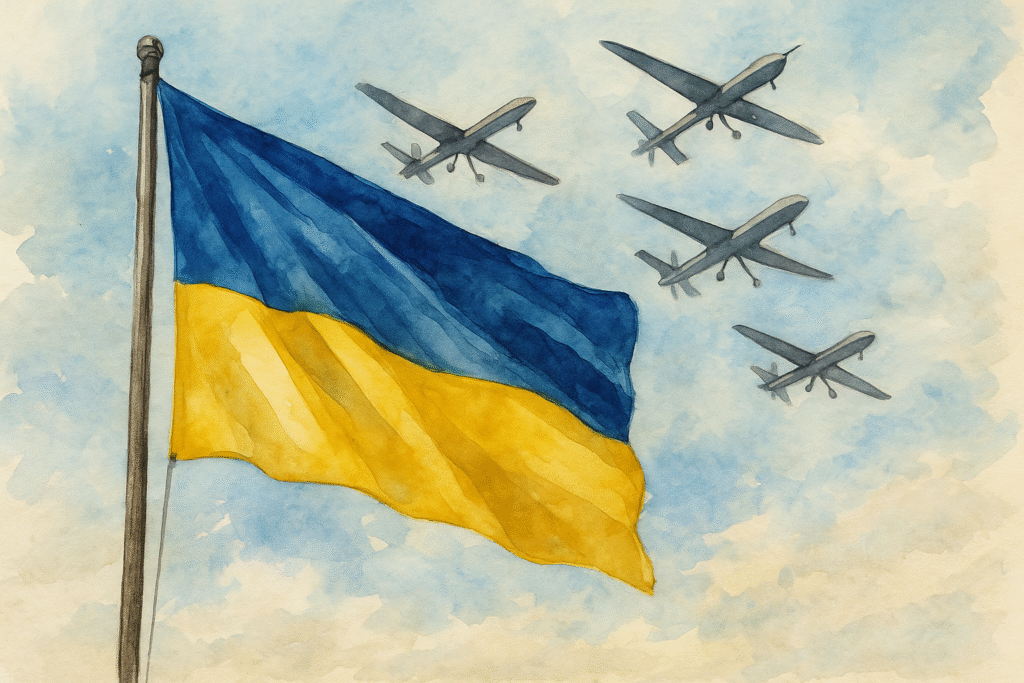From Command to Drones: How Ukraine Integrates AI into Its Military Strategy

The war in Ukraine has become a living laboratory for Artificial Intelligence in Warfare. Amid destruction and technological race, Ukraine is deploying AI systems across nearly every level of its command structure — from troop coordination to autonomous drones. This integration is redefining how we understand modern conflict and marking a turning point in the evolution of warfare itself.
While the term “AI in war” evokes both fascination and ethical unease, the current reality in Ukraine is a complex blend of algorithms, humans, and machines working together. The operational pattern follows the “human-in-the-loop” principle — AI assists, but humans retain control. The result? A military that reacts faster, adapts in real time, and drastically shortens the gap between detection and action.
1. The Brain of Modern Warfare: The DELTA System
At the heart of this transformation is DELTA, Ukraine’s command, control, and intelligence platform (C2/ISR). Initially designed as a digital battlefield management tool, DELTA has evolved into an AI-powered decision-support system capable of real-time analysis and automatic target detection.
DELTA now integrates satellite imagery, drone feeds, and sensor data to identify and classify enemy equipment with near-instant precision. It automatically alerts commanders and prioritizes targets based on impact and accuracy probability — cutting decision-making cycles from hours to minutes.
It also connects seamlessly with tactical systems such as Kropyva — a field artillery coordination app — and GisArta, Ukraine’s indirect-fire ecosystem. Together, these platforms have reduced the “sensor-to-shooter” cycle by up to 75%, according to independent military analyses.
1.1. Kropyva: The App That Became a Weapon
Kropyva (“nettle” in Ukrainian) may look like a simple battlefield app, but it has become one of the most transformative digital tools of the war. It provides precise geolocation, instant communication, and trajectory calculations — and now, with AI-driven prediction algorithms, it can even anticipate enemy movements.
Among soldiers, Kropyva is affectionately called “the WhatsApp of Ukrainian artillery.” It’s fast, intuitive, and lethal — the perfect example of how Artificial Intelligence in Warfare is reshaping command dynamics.
2. Smart Drones: The Eyes and Hands of AI
When discussing Artificial Intelligence in Warfare, drones are the most visible embodiment of this evolution. Ukraine has expanded drone operations at an unprecedented rate, with many now equipped with onboard AI for autonomous detection, tracking, and target coordination.
Models like the Saker Scout and SkyKnight2 can automatically identify and follow targets while transmitting coordinates directly to DELTA. These systems leverage edge computing — processing data locally — reducing reliance on satellite connections and countering electronic warfare interference.
2.1. Swarms: The Rise of AI Coordination
One of the most ambitious developments is the experimentation with AI-coordinated drone swarms. Known as the “Swarmer Project,” this initiative aims to synchronize dozens of drones after launch, dividing tasks such as reconnaissance, attack, and distraction among them.
Though still in early testing stages, the concept represents a major leap toward autonomous coordination — where drones operate like a living organism. Reports suggest Ukraine has already field-tested limited swarm prototypes in controlled combat zones in the east.
3. Defense and Counter-Drone Systems: AI Versus AI
Where there are AI attack drones, there are also AI defense systems. Ukrainian startups, in collaboration with the Ministry of Defense, are building computer vision platforms capable of identifying ambushes and incoming drones in supply routes and logistics chains.
One notable project is Blue Eyes by Dropla — a system combining optical and thermal imaging to detect aerial threats and send real-time alerts to convoy operators. It’s currently undergoing field testing and already showing promise in preventing surprise attacks.
Other defensive AI prototypes use acoustic analysis to recognize the distinctive hum of FPV drones, triggering automated countermeasures or jamming. The goal is a cognitive defense layer — a network where each vehicle or base has its own onboard “AI guardian.”
4. Geospatial Intelligence and AI-Based Training
Modern warfare depends heavily on GEOINT (Geospatial Intelligence). Ukraine uses AI to process vast amounts of satellite data, identifying troop movements, infrastructure damage, and logistic flows. Machine learning models reveal hidden patterns and predict potential enemy maneuvers with increasing precision.
AI also plays a growing role in virtual combat simulations for troop training. These systems recreate battle conditions using real-world data, providing instant feedback to soldiers and officers. It accelerates tactical learning and enables strategic experimentation without human risk.
4.1. Governance and Ethics: Keeping AI Under Control
Global defense think tanks such as CEPA and RUSI describe the Ukraine conflict as a “real-time military AI laboratory.” Amid innovation, Ukraine and its allies have been careful to maintain compliance with international humanitarian standards — ensuring human decision authority remains intact.
The “human-in-the-loop” principle is central to this effort: AI can suggest, analyze, and predict, but the final lethal decision always rests with a person. This balance is essential to preventing escalation or ethical violations.
5. What’s Not True: Myths About Fully Autonomous Warfare
Despite the headlines, the war in Ukraine is far from fully autonomous. No country currently deploys AI or machine learning (ML) on a large scale without human supervision. The operational standard remains semi-autonomy with human oversight.
This limitation stems from multiple factors: electronic interference, hardware costs, communication bandwidth constraints, and the moral implications of delegating life-and-death decisions to machines. So far, automation acts as a force multiplier — not a replacement for human judgment.
5.1. Human and Machine: Partners, Not Rivals
Rather than replacing soldiers, AI enhances their performance. It accelerates decision-making, reduces cognitive load, and minimizes error. War remains, fundamentally, a human endeavor — but the flow of information and precision of choices have changed forever.
6. Scale and Impact: Ukraine as an AI Warfare Laboratory
Experts often describe Ukraine as the world’s first large-scale AI-enabled conflict. The technologies developed and tested there are influencing defense programs worldwide — including in the U.S., U.K., Israel, and South Korea.
This “war-time innovation cycle” is unique. Local startups deploy prototypes in the field, collect feedback, and iterate in weeks. It’s an agile, startup-like process — except the testing ground is a live battlefield.
According to the Brookings Institution, this accelerated pace of AI integration in military contexts is unprecedented — and forces policymakers to rethink what “technological superiority” really means.
7. Challenges Ahead: Digital Sovereignty and Technological Dependence
With AI integration comes a new vulnerability: technological dependence. Ukraine relies heavily on cloud infrastructure and Western machine learning frameworks, which raises concerns about cybersecurity and long-term sovereignty.
To address this, the Ukrainian government — supported by NATO partners — is investing in domestic AI development. New programs aim to train local engineers, secure data sovereignty, and reduce reliance on foreign software. In the long run, this could redefine Europe’s digital defense posture.
8. Conclusion: The Dawn of a New Era in Warfare
Artificial Intelligence in Warfare is no longer science fiction — it’s unfolding before our eyes. Ukraine has become the first nation to deploy AI on a broad, strategic level in real combat, blending innovation with restraint.
The lesson is clear: the future of defense will be hybrid, where human insight and machine precision coexist. Full autonomy remains distant, but the evolution is irreversible — algorithms now shape battlefields as much as bullets do.
The rise of Artificial Intelligence in Warfare blurs the line between technology and humanity. Ukraine’s example is both a warning and a beacon — showing how innovation, even in crisis, reshapes the future of defense.
👉 Want to explore how AI is transforming the real world? Follow our analyses on TechInNess and subscribe to our newsletter for exclusive content on AI, innovation, and the future of technology.
💬 Frequently Asked Questions (FAQ)
- Does Ukraine actually use AI in combat?
Yes, primarily for reconnaissance, targeting, and artillery coordination. - Are Ukrainian drones fully autonomous?
No. They operate semi-autonomously, always under human supervision. - Is the DELTA system public?
No. It’s classified, though its core features are described in official reports. - Does Ukraine use defensive AI?
Yes — systems like Blue Eyes detect drone ambushes and aerial threats. - Is AI warfare legal under international law?
Yes, as long as the human-in-the-loop principle is upheld. - Does Russia use AI too?
Yes, though with more emphasis on electronic warfare and digital propaganda.



